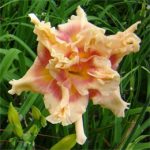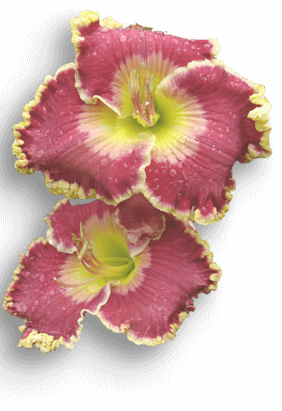A more recent registration class based on form, its definition states: The Unusual Form class is based exclusively on form, not on color or color patterns. The flower must have distinctive petal or sepal shapes on all three petals or all three sepals. It includes three basic forms: crispate, cascade and spatulate.
The crispate form is further defined below. Ideally, there should be minimal overlap with a v-shaped space between 3 or more floral segments.
For garden judges, the UF multiforms are eligible for the Lambert/Webster award.
For exhibition judges, the multiforms shown here are all exhibited in Section 5, Doubles. Exhibition judges should see Multiform Classification for further information.
Crispate:
Pinched, twisted, or quilled floral segments
Pinched Crispates:
Definition: floral segments which have sharp folds giving a pinched or folded effect. See below for pinched crispate illustration.
- H. ‘White Eyes Pink Dragon’ (Gossard, 2006) Lambert/Webster Award, 2014 Photo by Jamie Gossard
- H. ‘Firefly Frenzy’ (Joiner-J., 2002) Lambert/Webster Award, 2016 Photo by Jan Joiner
Twisted Crispates
Definition: floral segments which present a corkscrew or pinwheel effect. See below for twisted crispate illustration.
Quilled Crispates
Definition: floral segments which turn upon themselves along their length to form a tubular shape. See below for quilled crispate illustration. (Although not registered as quilled, H. ‘Arms Reaching Out’ typically illustrates this form on its sepals)
- H. ‘Fully Artful’ (Ripley, 2018) Photo by Nan Ripley
- H. ‘Arms Reaching Out’ (Eller-N., 2004) Photo by Nancy Eller, used with permission
Cascade
Definition: floral segments with narrow curling or cascading segments, resembling wood shavings. See below for cascade illustration.
- H. ‘Thin Man’ (Trimmer, 2002) Lambert/Webster Award, 2008 Photo by Julie Covington
- H. ‘Spiral Distraction (Elliott-S., 2016). Photo by Scott Elliott
Spatulates
Definition: segments markedly wider at the end like a kitchen spatula. See below for spatulate illustration.
- H. ‘Asterisk’ (Lambert, 1985) Photo by Scott Elliott
- H. ‘Aubree’s Angel’ (Otto-C., 2011) Photo by Cheryl Otto
The purpose of this class is to recognize daylilies whose length-to-width ratio puts them outside the Spider classifications.
The AHS makes available a list of officially registered unusual form daylilies each year. It can be downloaded free from www.daylilies.org. Only daylilies that appear on this official list are eligible for entry in the unusual form section of the show. While multiform daylilies are eligible for the Lambert/Webster and Harris Olson Spider awards, multiform daylilies must be exhibited in the proper section as designated in the Multiform Classification Code.










